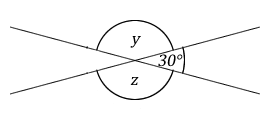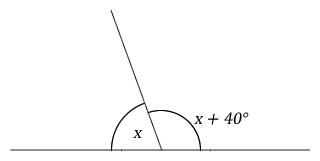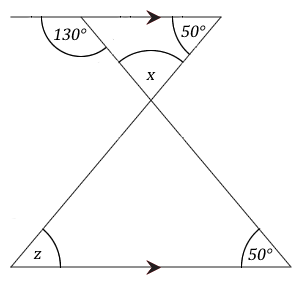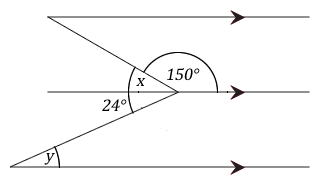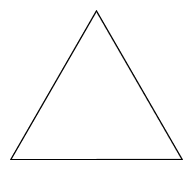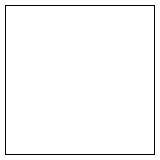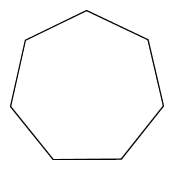Form 3 Mathematics
Chapter 7: Geometry 1
7.1. Introduction
7.2. Points, lines and angles
7.2.1. A right angle is equal to 90°
7.2.2. Vertically opposite angles are equal
7.2.3. Angles on a straight line add up to 180°
7.2.4. The sum of all angles in a triangle is 180°
7.2.5. The sum of all angles around a point is 360°
7.2.6. Corresponding angles are equal
7.2.7. Alternate angles are equal
7.3. Lines of symmetry
7.3.1. Rotational or point symmetry
7.4. Polygons
7.4.1. Properties of some common polygons
7.4.2. Regular polygons
7.4.3. Sum of interior and exterior angles of polygons
7.4.3.1. Interior angles of a polygon
7.4.3.2. Exterior angles of a polygon
7.5. Summary
7.6. Further reading
7.7. Test 7
7.1. Introduction
What you are going to learn in this unit is a continuation of the work you covered in Level one. You are going to learn about different types of angles in different types of shapes. the unit is also going to cover practical aspects on direct using angles.
Objectives
After going through this chapter, you should be able to
- identify types of angles such as right, straight, acute, obtuse and reflex angles, vertically opposite angles.
- state and use properties of n-sided polygons.
- identify special names given to n-sided polygons.
- identify, interpret and apply concepts points, line, segments, parallels and perpendiculars.
- identify lines of symmetry and order of symmetry of plane figures or shapes.
- use the exterior and interior angle properties of polygons.
Key terms
Acute - An angle that is less than 90°.
Convex – Having a surface that curves outward rather than inward.
Line of symmetry – A line which divides into two equal parts it is also called a mirror line.
Obtuse - An angle greater than 90º and less than 180º.
Polygon – Is any plane figure with straight edges or sides.
Regular –length and angles are of the same size.
Transversal line – Line which crosses or cut parallel lines.
Vertex – Point where two lines of a triangle meet, vertices when many.
Time
You should not spend more than 10 hours in this chapter.
Study skills
To understand geometry, you should familiarise yourself with the properties of angles. The key to mastery of mathematics is practice. You need to work out as many problems as possible about geometry to have a better understanding of the subject.
7.2. Points, lines and angles
There are many angle relationships in geometry. The most common relationships are explained as follows.
7.2.1. A right angle is equal to 90°
Figure 7.1 shows a right angle. This is an angle formed when two lines intersect at 90°. The angle is denoted by a small square at the point of intersection of the two lines.
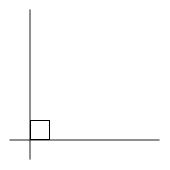
7.2.2. Vertically opposite angles are equal
Figure 7.2 shows that when two straight lines intersect we get vertically opposite angles. a is vertically opposite to c and b is vertically opposite to d.
Figure 7.2: Vertically opposite angles
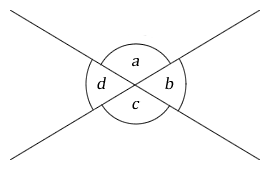
7.2.3. Angles on a straight line add up to 180°
Figure 7.3 shows two angles which are adjacent. They are on a straight line and they add up to 180°. x + y = 180°.
Figure 7.3: Angles on a straight line
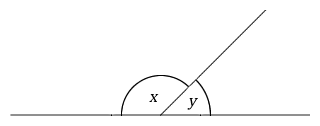
7.2.4. The sum of all angles in a triangle is 180°
Figure 7.4 shows three angles a, b and c in a triangle. The angles add up to 180°. a + b + c = 180°.
Figure 7.4: Angles in a triangle
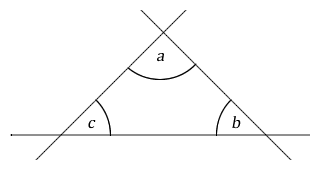
7.2.5. The sum of all angles around a point add up to 360°
Figure 7.5 shows that all the angles a, b and c around a point add up to 360°. a + b + c = 360°.
Figure 7.5: Angles around a point
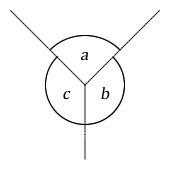
7.2.6. Corresponding angles are equal
Figure 7.6 shows two angles a and b. These angles are formed by a line which intersects two parallel lines. The two angles are equal and are known as corresponding angles. Corresponding angles can be found by looking for an ‘F’ formation in the diagram.
Figure 7.6: Corresponding angles
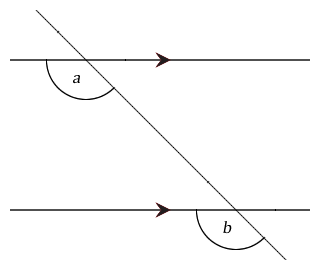
Figure 7.7 is a variation of the ‘F’ formation diagram depicting corresponding angles.
Figure 7.7: Corresponding angles
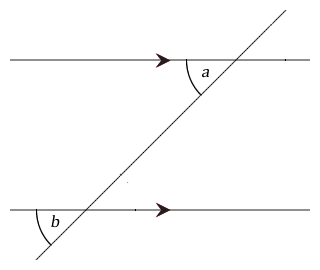
7.2.7. Alternate angles are equal
Figure 7.8 shows two angles a and c. These angles are formed by a line which intersects two parallel lines. The two angles are equal and are known as alternate angles. Alternate angles can be found by looking for a ‘Z’ formation in the diagram.
Figure 7.8: Alternate angles
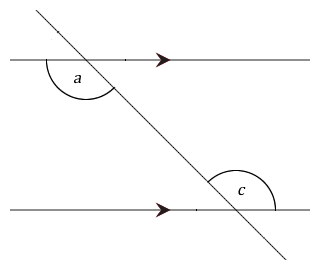
Figure 7.9 is a variation of the ‘Z’ formation diagram depicting alternate angles.
Figure 7.9: Alternate angles
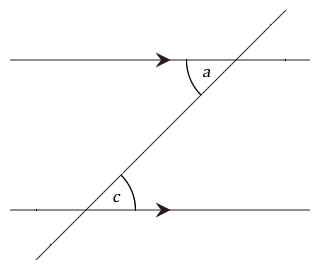
Example 1
Questions
-
Find the values of x and y in the following diagram.
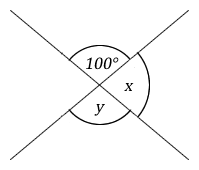
-
Use the following diagram to find the lettered angles.

Answers
-
100° + x = 180°
x = 180° – 100°
x = 80°
y is vertically opposite to the 100° angle.
y = 100° -
a + 120° = 180° (angles on a straight line)
a = 180° – 120°
a = 60°
c is an alternate angle to the 45° angle.
c = 45°
The sum of all angles in a triangle is 180°
a + b + c = 180°
60° + b + 45° = 180°
b + 105° = 180°
b = 180° - 105°
b = 75°
d is vertically opposite to the b angle.
d = b
d = 75°
You may attempt the following exercise.
Exercise 7.1: Points, lines and angles
Questions
-
Using angle properties, calculate the value of the unknown angles in each of these questions.
-
Answers
-
- x = 67°
- y = 150°, z = 150°
- x = 15°
-
- x = 29°
- x = 70°
-
- x = 80°, z = 50°
- x = 30°, y = 24°
7.3. Lines of symmetry
The line of symmetry can be defined as the axis or imaginary line that passes through the centre of the shape or object and divides it into identical halves.
The following shapes show their respective number of lines of symmetry.
Figure 7.19: Isosceles triangle
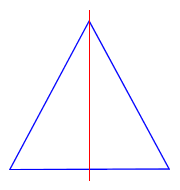
Figure 7.20: Square

Figure 7.21: Rounded rectangle
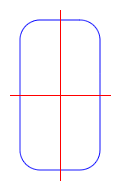
7.3.1. Rotational or point symmetry
A two-dimensional shape has rotational symmetry if, when rotated about a central point, it fits its outline. Rotation can be clockwise or anticlockwise. The number of times it fits its outline during a complete revolution is called the order of rotational symmetry.
An equilateral triangle will fit exactly onto itself three times before it comes to its original position. Therefore its order of rotational symmetry is 3.
Figure 7.22: Rotational symmetry of an equilateral triangle
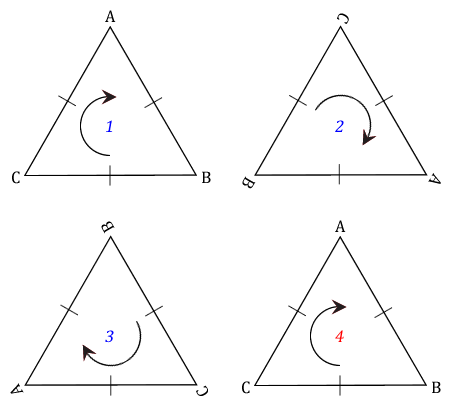
The rotation is clockwise and it is rotating through 120°, check the positions of A until it gets back to its starting point.
A rectangle will behave different from an equilateral triangle. In the first rotation, the rectangle will be vertical and in the second rotation it will be horizontal and fit its self. Hence it has the order 2 of rotational symmetry.
Figure 7.23: Rotational symmetry of a rectangle
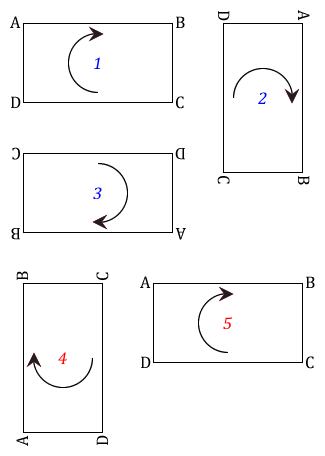
You may attempt the following exercise.
Exercise 7.2: Symmetry
Questions
-
Complete table 7.1. The first two have been done for you.
Hint: Make or draw these shapes, fold the shape to see the lines of symmetry and rotate shape to see order of rotation.
Table 7.1: Lines of symmetry and order of rotation
Shape Lines of symmetry Order of rotational symmetry Rectangle 2 2 Kite 1 2 Rhombus Circle Rectangle Parallelogram Regular hexagon Isosceles triangle Equilateral triangle
Answers
-
Table 7.1: Lines of symmetry and order of rotation
Shape Lines of symmetry Order of rotational symmetry Rectangle 2 2 Kite 1 2 Rhombus 2 2 Circle Infinity Infinity Rectangle 2 2 Parallelogram 0 2 Regular hexagon 6 6 Isosceles triangle 2 - Equilateral triangle 3 3
7.4. Polygons
The meaning of the word polygon is defined when the word is separated as follows:
- Poly - many.
- Gon - angles.
Therefore, a triangle is a three sided polygon and a quadrilateral is a four sided polygon. Tri means three (3) and quad means four (4). Thus, polygons are named according to the number of angle or sides they have. Examples of polygons are shown in Table 7.2.
Table 7.2: Examples of polygons
| Polygon | Sides / angles | Triangle(s) |
|---|---|---|
| Triangle | 3 | 1 |
| Quadrilateral | 4 | 2 |
| Pentagon | 5 | 3 |
| Hexagon | 6 | 4 |
| Heptagon | 7 | 5 |
| Octagon | 8 | 6 |
| Nonagon | 9 | 7 |
| Decagon | 10 | 8 |
7.4.1. Properties of some common polygons
Square - All sides are equal, opposite sides are parallel and all angles are right angles. Diagonals are equal and bisect each other at 90° at the centre.
Rhombus - All sides are equal, opposite sides are parallel, opposite angles are equal, one pair of its sides is acute and the other pair is obtuse.
Rectangle - All angles are right angles, diagonals are equal, opposite sides are equal and parallel and diagonals bisect each other at the centre.
Parallelogram - Opposite sides are equal and parallel, diagonals bisect each other at 90°, one pair of its angles is acute, diagonals bisect the angles and another pair of its angles is obtuse.
Trapezium - One pair of its sides is parallel and at least one angle is obtuse.
Kite - Its adjacent sides are equal, one pair of its opposite angles are equal and longer diagonal bisect shorter at 90°.
These properties will help you to calculate angles and sides.
7.4.2. Regular polygons
A regular polygon is a polygon in which all its sides are of equal length and all its angles are of equal size.
Figure 7.24: Equilateral triangle

Figure 7.25: Square (regular quadrilateral)
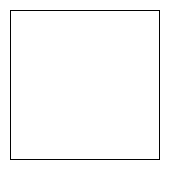
Figure 7.26: Regular pentagon
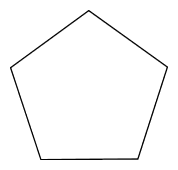
Figure 7.27: Regular hexagon
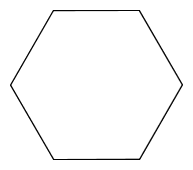
Regular polygons have two kinds of angles as shown in figure 7.28.
Figure 7.28: Angles of a regular polygon
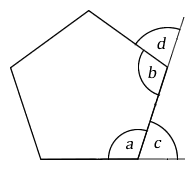
a and b are examples of interior angles. c and d are examples of exterior angles. a and c are adjacent to each other and they add up to 180°. The exterior angles of any polygon always add up to 360°.
You may attempt the following exercise.
Exercise 7.3: Properties of polygons
Questions
-
The following diagram shows a regular pentagon EFGHJ with centre O.
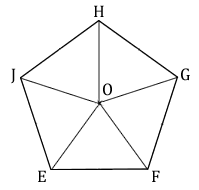
- How many angles are at the centre O?
- Calculate the side of each angle at the centre.
- Find the sum of its angles at O.
- Calculate angles OEF and OFE.
- What name is given to triangle EOF?
-
How many lines of symmetry in each of the following regular polygons?
-
Answers
-
- 5
- 72°
- 360°
- 54°
- Isosceles triangle
-
- 3
- 4
- 5
- 6
- 7
7.4.3. Sum of interior and exterior angles of polygons
7.4.3.1. Interior angles of a polygon


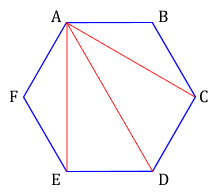
If a straight line is drawn from each vertex to vertex A, triangles will be produced. The number of triangles produced is always 2 less than the number of sides the polygon has. For example, if there are n sides, there will be (n – 2) triangles produced.
Since there are 2 triangles less than the number of sides of the polygon, the sum of interior angles any n-sided polygon is (n – 2) × 180°. You can check this by working out the sum of the angles of a triangle and rectangle which you already know.
Example 2
Questions
-
Find the sum of the interior angles of a
- triangle
- rectangle
Answers
-
The sum of angles in a triangle
= (n – 2) × 180°
= (3 – 2) × 180°
= 1 × 180°
= 180° -
The sum of angles in a rectangle
= (n – 2) × 180°
= (4 – 2) × 180°
= 2 × 180°
= 360°
You may attempt the following exercise.
Exercise 7.4: Sum of interior angles
Questions
-
Calculate the sum of the interior angles of a regular
- Pentagon
- Heptagon
- Octagon
Answers
- 540°
- 900°
- 1080°
Let us look into some more examples. This time we would like to look at how to find the number of sides of a polygon given the sum of its interior angles.
Example 3
Questions
- The sum of interior angles of a regular polygon is = 1440°. How many sides does the polygon has?
Answers
-
The sum of interior angles of n-sided polygon is (n – 2) × 180°.
1440° = (n – 2) × 180°
1440° = 180°n – 360°
1440° - 360° = 180°n
1080° = 180°n
\( n = \dfrac{1080°}{180°} \)
n = 6
The polygon has 6 sides.
Note: Sometimes you may see the formula (2n – 4) × 90°. Do not be confused by that because 2n – 4 is the number of right angles in the polygon. You can also see that if you divide (2n – 4) by 2 and multiply 90° by 2 then you will go back to (n – 2) × 180°, the sum of interior angles of n-sided polygon.
You may attempt the following exercise.
Exercise 7.5: Sum of interior angles
Questions
-
Calculate the sum of interior angles by completing Table 7.3. The first one been done for you.
Table 7.3: Sum of interior angles
Polygon Sides / angles Triangle(s) Sum of angles at O Sum of angles Pentagon 5 5 360° 5 × 180 – 360 = 540° Hexagon Heptagon Octagon
- The sum of the angles of a polygon is 1980°. How many sides does the polygon has?
- A polygon has 16 sides. Calculate the sum of its interior angles.
Answers
-
Table 7.3: Sum of interior angles
Polygon Sides / angles Triangle(s) Sum of angles at O Sum of angles Pentagon 5 5 360° 5 × 180 – 360 = 540° Hexagon 6 6 360° 6 × 180 – 360 = 720° Heptagon 7 7 360° 7 × 180 – 360 = 900° Octagon 8 8 360° 8 × 180 – 360 = 1080°
- 9
- 2520°
7.4.3.2. Exterior angles of a polygon
The sum of the exterior angles of any regular polygon is 360°.
Example 4
Questions
- Calculate the exterior and interior angles of regular nonagon.
- How many sides has a regular polygon if each interior angle is 150°.
Answers
-
Nonagon has 9 sides. Hence:
Exterior angle = \( 360° \over 9 \) = 40°.
Interior angle = 180° - 40° = 140°. -
To find the number of sides,
Interior angle = 150°
Exterior angle = 180° - 150° = 30°
Number of sides = \( 360° \over 30° \) = 12
The polygon has 12 sides.
Note: The interior angle of any polygon is adjacent to the exterior angle and when you add the two you get a straight angle which is 180°. Since regular means equal we divide 360° by number of sides.
You may attempt the following exercise.
Exercise 7.6: Sides and angles of regular polygons
Questions
- Find the number of sides of a regular polygon, if the exterior angle is 36°.
-
Calculate the number of sides of a regular polygon whose interior angles are:
- 168°.
- 156°.
- 144°.
- Find the number of sides of a polygon if its interior angles add up to 1620°.
-
A hexagon has the following angles: x, 2x, 3x, 4x, 5x and 6x. Calculate the
- value of x.
- size of exterior angle.
-
Calculate the number of sides of a regular polygon if the exterior angle is
- 24°.
- 90°.
- 15°.
-
Calculate the number of sides of a regular polygon whose interior angle is
- 140°.
- 150°.
- 120°.
Answers
- 10
-
- 30
- 15
- 10
- 7
-
- 34.3°
- 60°
-
- 15
- 4
- 24
-
- 9
- 12
- 6
7.5. Summary
Polygons are named according to the number of their sides. A regular polygon has all of its sides the same length and all of its angles the same size. A formula for calculating the sum of the interior angles of an n-sided polygon was seen to be (n – 2) × 180° or (2n – 4) × 90° right angles. The same formula can be used to find number of sides of an n-sided polygon. The sum of the exterior angles of any polygon is 360°.
7.6. Further reading
- Macrae, M. F., Madungwe, L. and Mutangadura, A. (2017). New General Mathematics Book 3. Pearson Capetown.
- Macrae, M. F., Madungwe, L. and Mutangadura, A. (2017). New General Mathematics Book 4. Pearson Capetown.
- Meyers, C., Graham, B., Dawe, L. (2004). Mathscape Working Mathematically. 9th Edition. MacMillan.
- Pimentel, R. and Wall, T. (2011). International Mathematics. Hodder UK.
- Rayner, D. (2005). Extended Mathematics. Oxford New York.
7.7. Test 7
Questions
-
Calculate the sizes of angle marked with a letter on the diagram.

-
What do you know about
- supplementary angles?
- alternate angles?
- complementary angles
-
If a regular polygon is 7-sided,
- what is it called?
-
find the sum of its
- interior angles.
- exterior angles.
-
Calculate the number of sides of a regular polygon whose
- exterior angle is 36°.
- interior angle is 140°.
- Find the size of each interior angle of a 20-sided regular polygon.
-
Using the following diagram,
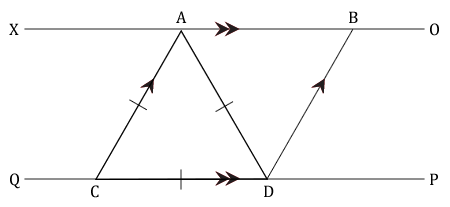
- calculate angle BDP.
- calculate angle XAQ.
- what name is given to triangle ABD
- A hexagon has (2x)°, (12 + x)°, (4 + 3x)° and the other 3 angles are (x + 10)° each. Calculate the value of x.
-
Using the following diagram,
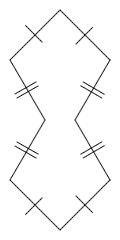
- what is the order of rotational symmetry of the shape?
- how many lines of symmetry does the shape has?
Answers
- x = 120°, y = 30°
-
- Add up to 180°
- Add up to 180°
- Add up to 90°
-
- Heptagon
-
- 900°
- 360°
-
- 10
- 9
- 162°
-
- 60°
- 120°
- Isosceles
- 66.1°
-
- 2
- 2


